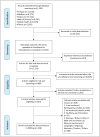The lymphatic filariasis treatment study landscape: A systematic review of study characteristics and the case for an individual participant data platform
- PMID: 38227595
- PMCID: PMC10817204
- DOI: 10.1371/journal.pntd.0011882
The lymphatic filariasis treatment study landscape: A systematic review of study characteristics and the case for an individual participant data platform
Abstract
Background: Lymphatic filariasis (LF) is a neglected tropical disease (NTD) targeted by the World Health Organization for elimination as a public health problem (EPHP). Since 2000, more than 9 billion treatments of antifilarial medicines have been distributed through mass drug administration (MDA) programmes in 72 endemic countries and 17 countries have reached EPHP. Yet in 2021, nearly 900 million people still required MDA with combinations of albendazole, diethylcarbamazine and/or ivermectin. Despite the reliance on these drugs, there remain gaps in understanding of variation in responses to treatment. As demonstrated for other infectious diseases, some urgent questions could be addressed by conducting individual participant data (IPD) meta-analyses. Here, we present the results of a systematic literature review to estimate the abundance of IPD on pre- and post-intervention indicators of infection and/or morbidity and assess the feasibility of building a global data repository.
Methodology: We searched literature published between 1st January 2000 and 5th May 2023 in 15 databases to identify prospective studies assessing LF treatment and/or morbidity management and disease prevention (MMDP) approaches. We considered only studies where individual participants were diagnosed with LF infection or disease and were followed up on at least one occasion after receiving an intervention/treatment.
Principal findings: We identified 138 eligible studies from 23 countries, having followed up an estimated 29,842 participants after intervention. We estimate 14,800 (49.6%) IPD on pre- and post-intervention infection indicators including microfilaraemia, circulating filarial antigen and/or ultrasound indicators measured before and after intervention using 8 drugs administered in various combinations. We identified 33 studies on MMDP, estimating 6,102 (20.4%) IPD on pre- and post-intervention clinical morbidity indicators only. A further 8,940 IPD cover a mixture of infection and morbidity outcomes measured with other diagnostics, from participants followed for adverse event outcomes only or recruited after initial intervention.
Conclusions: The LF treatment study landscape is heterogeneous, but the abundance of studies and related IPD suggest that establishing a global data repository to facilitate IPD meta-analyses would be feasible and useful to address unresolved questions on variation in treatment outcomes across geographies, demographics and in underrepresented groups. New studies using more standardized approaches should be initiated to address the scarcity and inconsistency of data on morbidity management.
Copyright: © 2024 Freitas et al. This is an open access article distributed under the terms of the Creative Commons Attribution License, which permits unrestricted use, distribution, and reproduction in any medium, provided the original author and source are credited.
Conflict of interest statement
The authors have declared that no competing interests exist.
Figures




Similar articles
-
Albendazole alone or in combination with microfilaricidal drugs for lymphatic filariasis.Cochrane Database Syst Rev. 2019 Jan 8;1(1):CD003753. doi: 10.1002/14651858.CD003753.pub4. Cochrane Database Syst Rev. 2019. PMID: 30620051 Free PMC article.
-
An analysis of the safety of the single dose, two drug regimens used in programmes to eliminate lymphatic filariasis.Parasitology. 2000;121 Suppl:S147-60. doi: 10.1017/s0031182000007423. Parasitology. 2000. PMID: 11386686 Review.
-
Identifying co-endemic areas for major filarial infections in sub-Saharan Africa: seeking synergies and preventing severe adverse events during mass drug administration campaigns.Parasit Vectors. 2018 Jan 31;11(1):70. doi: 10.1186/s13071-018-2655-5. Parasit Vectors. 2018. PMID: 29382363 Free PMC article.
-
Mathematical modelling of lymphatic filariasis elimination programmes in India: required duration of mass drug administration and post-treatment level of infection indicators.Parasit Vectors. 2016 Sep 13;9(1):501. doi: 10.1186/s13071-016-1768-y. Parasit Vectors. 2016. PMID: 27624157 Free PMC article.
-
The Global Programme to Eliminate Lymphatic Filariasis: health impact during its first 8 years (2000-2007).Ann Trop Med Parasitol. 2009 Oct;103 Suppl 1:S17-21. doi: 10.1179/000349809X12502035776513. Ann Trop Med Parasitol. 2009. PMID: 19843394
Cited by
-
Acceptability of mass drug administration for lymphatic filariasis in Baglung Municipality of Nepal: A mixed-method study.PLOS Glob Public Health. 2025 Jul 21;5(7):e0004910. doi: 10.1371/journal.pgph.0004910. eCollection 2025. PLOS Glob Public Health. 2025. PMID: 40690475 Free PMC article.
-
Mapping lymphatic filariasis morbidities in 24 endemic districts of Ethiopia through the health extension program.Trop Med Health. 2024 Nov 13;52(1):85. doi: 10.1186/s41182-024-00657-6. Trop Med Health. 2024. PMID: 39538312 Free PMC article.
References
-
- World Health Organization, 2021. Ending the neglect to attain the Sustainable Development Goals: a road map for neglected tropical diseases 2021–2030. https://www.who.int/publications/i/item/9789240010352.
-
- World Health Organization. Global programme to eliminate lymphatic filariasis: progress report, 2021. Wkly Epidemiol Rec 2022; 41: 513–524. Available from https://www.who.int/publications/i/item/who-wer9741-513-524.
-
- World Health Organization, 2023. Lymphatic Filariasis–Key facts. https://www.who.int/news-room/fact-sheets/detail/lymphatic-filariasis.
Publication types
MeSH terms
Substances
LinkOut - more resources
Full Text Sources
Research Materials

